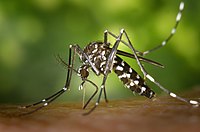
Photo from wikipedia
Background Pyrethroid insecticides are widely used in many countries for chemical-based control of Ae. aegypti. Regardless of their efficacy, the constant use of insecticides has induced insecticide resistance mechanisms, such… Click to show full abstract
Background Pyrethroid insecticides are widely used in many countries for chemical-based control of Ae. aegypti. Regardless of their efficacy, the constant use of insecticides has induced insecticide resistance mechanisms, such as knockdown resistance (kdr) in mosquitoes. Sri Lankan Vector Controlling Entities (VCE) have been using a variety of pyrethroid insecticides as the primary approach for dengue control. However, development of any resistance among the Aedes mosquitoes has been limitedly studied in the country. Therefore, the current study was conducted to evaluate the prevalence of F1534C, V1016G, and S989P mutations among Ae. aegypti mosquito populations in three dengue endemic high-risk regions of Sri Lanka. Methodology. Immature (both pupae and larvae) stages of Ae. aegypti mosquitoes were collected from Colombo, Gampaha, and Kandy districts of Sri Lanka from February 2018 to December 2019. Polymerase Chain Reaction- (PCR-) based assay for molecular genotyping of mutations was performed to identify the prevalence of kdr mutations in collected Ae. aegypti populations, separately. The frequencies of the resistant and susceptible kdr alleles were determined by using the Hardy–Weinberg equilibrium. Results The Ae. aegypti populations from Colombo, Gampaha, and Kandy districts showed 46%, 42%, and 22% of F1534C mutation allele frequencies, along with 15%, 12%, and 6% of V1016G mutation allele frequencies, respectively. The mutation allele frequencies of S989 in Colombo, Gampaha, and Kandy districts were 9.5%, 8.5%, and 4.5%, respectively. The wild-type (PP) genotype remained predominant within all the three districts, whereas the homogenous (QQ) mutation genotype occurred only in minority. The abundance of Q allele frequency in Ae. aegypti mosquitoes was relatively higher for all the three mutations in Colombo. Conclusions The findings clearly indicate that long-term insecticide applications and multiple use of pyrethroids have led to the acquisition of kdr mutations, leading to the development of insecticide resistance among local Ae. aegypti populations, especially in the Colombo and Gampaha districts. Therefore, evaluation of the prevalence levels of these kdr mutations highlights the necessity for shifting towards novel vector control strategies.
Journal Title: BioMed Research International
Year Published: 2021
Link to full text (if available)
Share on Social Media: Sign Up to like & get
recommendations!